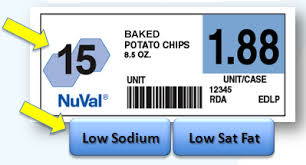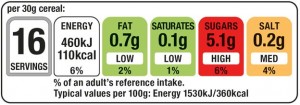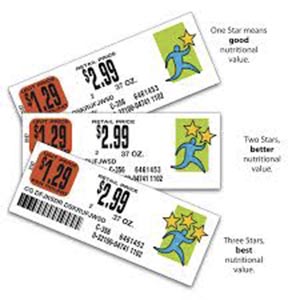A Wall Street Journal article (Feb. 16, 2016, A Hunger for Better Food Labels) discloses several food label updates that are under consideration. While we agree that an overhaul is needed, this is also potential for disaster.
The changes proposed by the FDA include: making the calorie information more prominent, changing the serving size to reflect the bigger portions that people eat, showing added sugar.
 Some think that it is still not clear enough. Here are proposed “better” labels:
Some think that it is still not clear enough. Here are proposed “better” labels:
 NUVAL score grades food on a scale of 1 to 100 based on many factors, positive or negative, including protein, calcium, sugar, cholesterol… It replaces the complex label by a single number.
NUVAL score grades food on a scale of 1 to 100 based on many factors, positive or negative, including protein, calcium, sugar, cholesterol… It replaces the complex label by a single number.
 Traffic light, developed in the UK, assigns a red yellow or green to the components that are deemed important: fat, saturated fat, sugar and salt.
Traffic light, developed in the UK, assigns a red yellow or green to the components that are deemed important: fat, saturated fat, sugar and salt.
 Guiding stars (developed in 2006) assigns 1, 2 or 3 stars to grade the food according to an algorithm that takes into account vitamins, minerals, fibers, sugar, fat, cholesterol.
Guiding stars (developed in 2006) assigns 1, 2 or 3 stars to grade the food according to an algorithm that takes into account vitamins, minerals, fibers, sugar, fat, cholesterol.
Our Opinion
The new FDA proposal for sugar is misleading. It focuses people’s attention on added sugar (when in fact natural sugar is not better than added sugar). This line of thought makes people eat a ton of fruit, not realizing that they are ingesting sugar at the same time and no more vitamins than in vegetables.
But it is only the least of evils… The other proposals make our hair stand on end:
At first glance, simplified labels are good idea. After all, navigating the maze of nutrition is hard and most people don’t have the time. What’s wrong with helping them save time and effort in buying their groceries?
- For starters, you’d have to trust the agencies to make the right choice for you. But, as everyone can understand, government recommendations are constrained by many factors other than pure science: practicality, the need to provide a diet affordable to all, politics, business interests, etc.
- You’d have to blindly trust the science that’s underlying the labeling. At this point, nutritional science is still shaky and has been proven wrong many times. Take dietary cholesterol for example…
- But most importantly, assessing ingredients using simplistic rules will not encourage people to consume a variety of foods. You could eat the same thing day in, day out, and still believe you are getting a “3 star” nutrition.
- Simplified labels don’t allow us to think for ourselves; since all we have to work with are those silly stars, we cannot rate our food ourselves. This might help a minority but not regular people.
Nobody will contest that food labels need improving. But the simplistic route is just not the solution.
If you found this post interesting,
sign-up to be notified when there is a new post on our blog.
